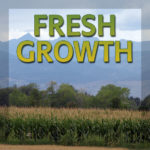The educational materials listed on this page are about Organic Matter.
Soil organic matter consists of three distinctly different parts—living organisms, fresh residues, and well-decomposed residues. These three parts of soil organic matter have been described as the living, the dead, and the very dead. A typical agricultural soil has 1% to 6% organic matter. The benefits of organic matter include improved soil structure, increased infiltration and water-holding capacity, increased cation exchange capacity, and more efficient long-term storage of plant nutrients. Without organic matter, you have no soil to speak of, only a dead mixture of ground-up and weathered rocks. Two comprehensive books to help you build soil organic matter and healthy soil are Building Soils for Better Crops and Managing Cover Crops Profitably.
The living part of soil organic matter includes a wide variety of microorganisms, such as bacteria, viruses, fungi, protozoa, and algae. It even includes plant roots and the insects, earthworms, and larger animals, such as moles, woodchucks, and rabbits that spend some of their time in the soil. The living portion represents about 15% of the total soil organic matter.
Microorganisms, earthworms, and insects feed on plant residues and manures for energy and nutrition, and in the process they mix organic matter into the mineral soil. In addition, they recycle plant nutrients. Organisms such as earthworms and some fungi also help to stabilize soil structure (for example, by producing channels that allow water to infiltrate) and, thereby, improve soil water status and aeration. Plant roots also interact in significant ways with the various microorganisms and animals living in the soil. A multitude of microorganisms, earthworms, and insects get their energy and nutrients by breaking down organic residues in soils.
The fresh residues, or “dead” organic matter, consist of recently deceased microorganisms, insects, earthworms, old plant roots, crop residues, and recently added manures. This part of soil organic matter is the active, or easily decomposed, fraction. This active fraction of soil organic matter is the main supply of food for various organisms—microorganisms, insects, and earthworms— living in the soil. As organic materials are decomposed by the “living,” they release many of the nutrients needed by plants. Organic chemical compounds produced during the decomposition of fresh residues also help to bind soil particles together and give the soil good structure.
Organic molecules directly released from cells of fresh residues, such as proteins, amino acids, sugars, and starches, are also considered part of this fresh organic matter. You can add fresh residues to improve soil health by composting, planting cover crops, and using conservation tillage practices.
The well-decomposed organic matter in soil, the “very dead,” is called humus. Some use the term humus to describe all soil organic matter; some use it to describe just the part you can’t see without a microscope. We’ll use the term to refer only to the well-decomposed part of soil organic matter. Because it is so stable and complex, the average age of humus in soils is usually more than 1,000 years. The already well-decomposed humus is not a food for organisms, but its very small size and chemical properties make it an important part of the soil. Humus holds on to some essential nutrients, storing them for slow release to plants. Humus also can surround certain potentially harmful chemicals and prevent them from causing damage to plants. Good amounts of soil humus can both lessen drainage and compaction problems that occur in clay soils and improve water retention in sandy soils by enhancing aggregation, which reduces soil density, and by holding on to and releasing water.
Showing 1-1 of 1 results

Fresh Growth Podcast
Fresh Growth: Approaches to a More Sustainable Future from Western Ag Practitioners introduces you to farmers and ranchers from around the western United States who are finding innovative sustainable practices that enrich the natural resources we all care about. These successful multi-generational operations experiment with new ideas and are making it pay. Listen in as […]